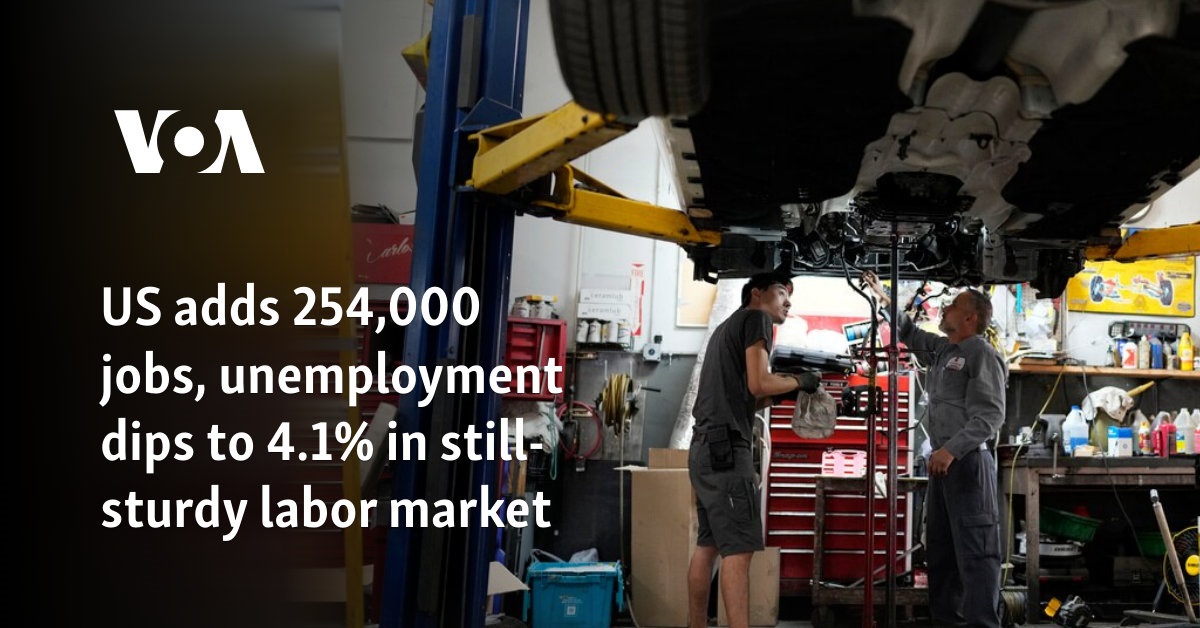Jobs
US adds 254,000 jobs, unemployment dips to 4.1% in still-sturdy labor market

America’s employers added a surprisingly strong 254,000 jobs in September, the latest evidence that the U.S. labor market is still solid enough to support steady hiring and a growing economy.
Last month’s hiring gain was far more than economists had expected, and it was up sharply from the 159,000 jobs that were added in August. And after rising for most of 2024, the unemployment rate dropped for a second straight month, from 4.2% in August to 4.1% in September, the Labor Department said Friday.
The latest figures suggest that many companies are still confident enough to fill jobs despite the continued pressure of high interest rates. Few employers are laying off workers, though many have grown more cautious about hiring.
In an encouraging sign, the Labor Department also revised up its estimate of job growth in July and August by a combined 72,000.
The September job gains were fairly broad-based, a healthy trend if it continues. Restaurants and bars added 69,000 jobs. Health care companies gained 45,000, government agencies 31,000, social assistance employers 27,000 and construction companies 25,000. A category that includes professional and business services added 17,000 after having lost jobs for three straight months.
Average hourly raises were solid, too. They rose by a higher-than-expected 0.4% from
August, slightly less than the 0.5% gain the month before. Measured from a year earlier, hourly wages climbed 4%, up a tick from a 3.9% year-over-year gain in August.
The economy’s progress in taming inflation led the Federal Reserve last month to cut its benchmark interest rate by a sizable half-point, its first rate cut in more than four years, and said further cuts were likely in the coming months. The Fed said it wanted to ease the cost of borrowing to help bolster the job market. Considering Friday’s strong jobs report, the Fed is now likely to reduce its key rate by more typical quarter-point increments.
“The September jobs report shows a nice bump in labor demand at the beginning of the fall,″ said Bill Adams, chief economist at Comerica Bank. “The U.S. economy is growing solidly in 2024 even as inflation slows to near the Fed’s target.”
The resilience of the economy has come as a relief. Economists had expected that the Fed’s aggressive campaign to subdue inflation — it jacked up interest rates 11 times in 2022 and 2023 — would cause a recession. It didn’t. The economy kept growing even in the face of ever-higher borrowing costs for consumers and businesses.
Most economists say the Fed appears to have achieved the once unlikely prospect of a “soft landing,” in which high interest rates help vanquish inflation without triggering a recession.
The economy is weighing heavily on voters as the Nov. 5 presidential election nears.
Many Americans are unimpressed by the job market’s durability and are still frustrated by high prices, which remain on average 19% above where they were in February 2021. That was when inflation began surging as the economy rebounded with unexpected speed and strength from the pandemic recession, causing severe shortages of goods and labor.
The public’s discontent with inflation and the economy under President Joe Biden has been a political burden for Vice President Kamala Harris in her race for the White House against former President Donald Trump.
The jobs report for October, which the government will issue four days before Election Day, will likely be muddied by the effects of Hurricane Helene and a strike by Boeing machinists.
Across the economy, though, most indicators look solid. The U.S. economy, the world’s largest, grew at a vigorous 3% annual pace from April through June, boosted by consumer spending and business investment. A forecasting tool from the Federal Reserve Bank of Atlanta points to slower but still healthy 2.5% annual growth in the just-ended July-September quarter.
The Institute for Supply Management, an association of purchasing managers, reported that America’s services businesses grew for a third straight month in September and at an unexpectedly fast pace. The economy’s service sector is closely watched because it represents more than 70% of U.S. jobs.
Last month, the nation’s households increased their spending at retailers. And even with hiring having slowed, Americans are enjoying unusual job security. Layoffs are near a record low as a percentage of employment. The number of people filing for unemployment benefits also remains near historically low levels.
Companies seem generally reluctant to let workers go even though some are also hesitant to expand their payrolls. That unusual dynamic may stem from many employers having been caught flat-footed and short of staff after the economy began roaring back from the pandemic recession. Posted job openings, too, have declined steadily, to 8 million in August, after having peaked at 12.2 million in March 2022.
Workers have noticed the chillier environment for jobseekers. Far fewer feel confident enough to leave their jobs to seek a better position. The number of Americans who are quitting their jobs has reached its lowest level since August 2020, when the economy was still reeling from COVID.









